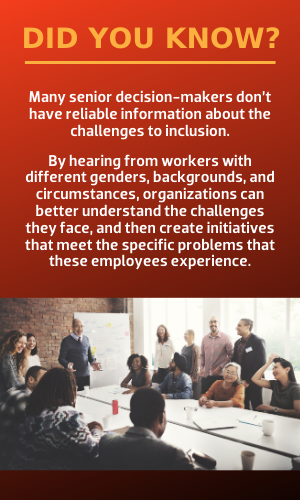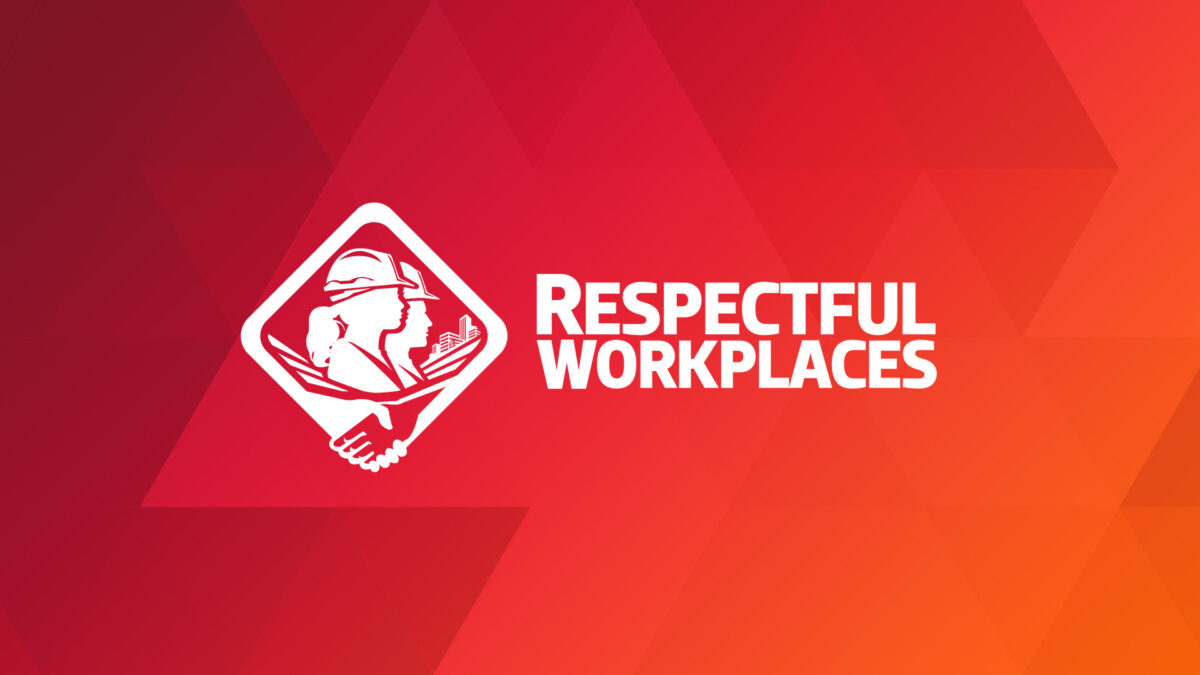Does your organization have the right information to make the right decisions about inclusion strategies?

Research shows that companies with a higher representation of people with different genders, backgrounds, and circumstances in their workforce and leadership team are more likely to have financial returns above their national industry medians.
Most corporate leaders want the benefits of a diverse workforce and leadership team.
In a study of 16,500 people in 14 countries across a range of industries, Boston Consulting Group found that 98% of these companies have established a respectful and inclusive workplace program.
Despite these efforts, however, the study also showed that only a quarter (21-28%) of employees with different genders, backgrounds, and circumstances feel that they have benefited from these programs.
The major reason for the disparity between the high proportion of respectful and inclusive workplace initiatives and the poor results is that leaders, the senior decision-makers who decide which programs to fund, underestimate the daily challenges that members of these diverse groups experience. The danger is that leaders may come to the conclusion that respectful and inclusive workplace initiatives aren’t worth undertaking because they don’t translate into results.
For example, the researchers note that many senior leaders believe that the recruiting phase presents the biggest obstacles, particularly for women and racial and ethnic minorities. It is not, however, that simple. In fact, members of these groups see more obstacles across the entire employee life cycle: recruiting, retention, advancement, and the commitment of leaders.
It’s easy to see how organizations can spend money on respectful and inclusive workplace initiatives that don’t generate results. The senior leaders who make decisions about how much to invest in these initiatives and which initiatives to fund may lack a clear understanding of how big the problems are or where those problems lie.
The researchers make the following recommendations to improve decision-making:
- Organizations should ensure that leaders hear from workers with different genders, backgrounds, and circumstances to better understand the challenges they face. Initiatives must meet specific problems that their diverse populations experience.
- Leaders must also demonstrate their own personal commitment to change by being very visible in their support. They must build a clear case for change, and communicate the ways that a more diverse workforce and leadership team will lead to better performance.
- Successful implementation requires true leadership commitment – much more than just superficial words or platitudes.
- Organizations must measure their current performance in recruiting, retaining, and advancing workers with different genders, backgrounds, and circumstances. Top-performing companies set clear, quantifiable diversity goals, measure their progress over time, and foster transparency by reporting their progress publicly.
- Organizations must also do the hard work of analyzing how an initiative will function on a day-to-day basis and how it will change the worker experience. It’s not enough to launch a program through the human resources department: the affected workers must be involved in the design and assessment of those programs. Leaders must secure buy-in and promotion across all business units, every level, and critically, from workers in the majority group.
Organizations may want to use the BuildForce Respectful Workplace Online Self-Assessment Tool as a management tool to raise awareness about the scope of respectful and inclusive workplace initiatives needed to successfully address the challenges faced by workers with different genders, backgrounds, and circumstances.
For more info:
- Boston Consulting Group. “Fixing the Flawed Approach to Diversity.” January 2019. See www.bcg.com/en-ca/publications/2019/fixing-the-flawed-approach-to-diversity.aspx.
Read from the beginning. Click here to start at Part 1.
What can an effective Respectful and Inclusive Workplace Program deliver?
- Become an employer of choice – attract, retain, and advance top talent from all sources of labour
- Unlock collaboration and innovation – create high-performing teams through diversity of thought and experience
- Build your brand – your organization will gain a competitive edge as a leader and innovator
Get started today!
The BuildForce Canada Online Respectful and Inclusive Workplace Toolkit includes:
- the Respectful Workplace Online Self-Assessment Tool to assist organization leadership in assessing their current situation and identifying where they may need to make changes
- the Respectful Workplace Policy Framework and Implementation Guide to assist organizations in creating and implementing a policy that supports a respectful and inclusive workplace
- the Respectful Workplace Online Training Course to train workers on how to create and support a respectful and inclusive workplace
- the online course Introduction to Understanding Systemic Racism: A Guide for Leaders and Managers
All the resources you need to create and support a respectful and inclusive workplace!

Respectful and Inclusive Workplaces
